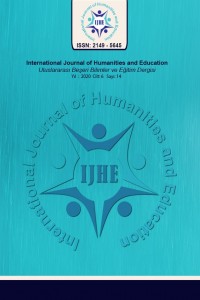Hedonik ve Yararcı Tüketim Değerinin Memnuniyet ve Davranışsal Niyetler Üzerindeki Etkisini Belirlemeye Yönelik Bir Araştırma
Abstract
Çalışmanın amacı, hedonik ve yararcı tüketim değerinin tüketicilerin fast food restoranları ile ilgili memnuniyetleri ve davranışsal niyetleri üzerindeki etkisinin analiz edilmesidir. Ayrıca çalışmada tüketicilerin fast food restoran tercih etmesinde etkili olan nitelikler belirlenmesidir. İlgili literatürden tüketim değeri, memnuniyet, davranışsal niyet ve restoran niteliklerine ilişkin ölçekleri içeren anket oluşturulmuştur. Çalışmada, kolayda örneklem yöntemi kullanılarak sosyal medya üzerinden internet anketi ile 333 kişiden kullanılabilir veri elde edilmiştir. Elde edilen verilerin analizleri ile ölçeklerin güvenirliliği ve geçerliliği gösterilmiştir. Çalışma modelindeki değişkenler arasında öngörülen ilişkileri test etmek üzere önce korelasyon analizi ardından da regresyon analizi gerçekleştirilmiştir. Korelasyon analizi sonucunda, hedonik ve yararcı tüketim değerleri, memnuniyet ve davranışsal niyetler arasında ilişki olduğu analiz edilmiştir. Regresyon analizi sonucunda hedonik ve yararcı tüketim değerinin fast food restoranlarında memnuniyet ve yeniden ziyaret etme niyeti üzerinde etkisi olduğu tespit edilmiştir. Bununla birlikte hedonik tüketim değerinin yararcı tüketim değerine göre bu noktada daha fazla etkisi olduğu tespit edilmiştir. Hedonik tüketim değerinin, tüketicilerin fast food restoranlarını tavsiye etmeleri ve daha sık ziyaret etme davranışları üzerinde etkisi bulunmaktadır. Son olarak, tüketicilerin fast food restoranlarını tercih etmesinde etkili olan niteliklerin fiyat (% 63,3), hızlı servis (% 63,3), yemeklerin lezzeti (% 57,2) ve menü çeşitliliği (% 49,7) olduğu tespit edilmiştir.
Keywords
Hedonik tüketim değeri Yararcı tüketim değeri Fast Food Restoranları Memnuniyet Davranışsal Niyet
References
- Avcıoğlu, G. Ş. (2014). Internet survey applications in social sciences: response rate, data quality, sample problems and solutions Sosyal bilimlerde internet anketi uygulamaları: cevaplama oranı, veri kalitesi, örneklem sorunları ve çözümleri. Journal of Human Sciences, 11(2), 89-113.
- Baek, S. H., Ham, S., & Yang, I. S. (2006). A cross-cultural comparison of fast food restaurant selection criteria between Korean and Filipino college students. International Journal of Hospitality Management, 25(4), 683-698. DOI: https://doi.org/10.1016/j.ijhm.2005.07.001.
- Büyüköztürk, Ş. (2014). Sosyal Bilimler İçin Veri Analizi El Kitabı. Pegem Akademi, Ankara.
- Cheang, M. (2002). Older adults' frequent visits to a fast-food restaurant: Nonobligatory social interaction and the significance of play in a “third place”. Journal of Aging Studies, 16(3), 303-321. DOI: https://doi.org/10.1016/S0890-4065(02)00052-X.
- Dursun, M. Toplumun McDonaldlaştırılması. İzmir Katip Çelebi Üniversitesi İktisadi ve İdari Bilimler Fakültesi Dergisi, 2(2), 202-207.
- Forsyth, A., Wall, M., Larson, N., Story, M., & Neumark-Sztainer, D. (2012). Do adolescents who live or go to school near fast-food restaurants eat more frequently from fast-food restaurants?. Health & place, 18(6), 1261-1269. DOI: https://doi.org/10.1016/j.healthplace.2012.09.005.
- Hamşıoğlu, A. B. (2013). Fast Food Ürünleri Satın Alan Tüketicilerin Yaşam Tarzlarını Belirlemeye Yönelik Bir Uygulama. International Journal of Economic & Administrative Studies, 6(11).
- Maslow, A. H. (1943). A theory of human motivation. Psychological review, 50(4), 370.DOI: https://psycnet.apa.org/doi/10.1037/h0054346.
- Ozcelik, A. O., Akan, L. S., & Surucuoglu, M. S. (2007). An evaluation of fast-food preferences according to gender. Humanity & Social Sciences Journal, 2(1), 43-50.
- Özdemır, B. (2010). Dışarıda Yemek Yeme Olgusu: Kuramsal Bir Model Önerisi. Anatolia: Turizm Arastirmalari Dergisi, 21(2).
- Park, C. (2004). Efficient or enjoyable? Consumer values of eating-out and fast food restaurant consumption in Korea. International Journal of Hospitality Management, 23(1), 87-94. DOI: https://doi.org/10.1016/j.ijhm.2003.08.001.
- Pettijohn, L. S., Pettijohn, C. E., & Luke, R. H. (1997). An evaluation of fast food restaurant satisfaction: determinants, competitive comparisons and impact on future patronage. Journal of Restaurant & Foodservice Marketing, 2(3), 3-20. DOI: https://doi.org/10.1300/J061v02n03_02.
- Rydell, S. A., Harnack, L. J., Oakes, J. M., Story, M., Jeffery, R. W., & French, S. A. (2008). Why eat at fast-food restaurants: reported reasons among frequent consumers. Journal of the American Dietetic Association, 108(12), 2066-2070. DOI: https://doi.org/10.1016/j.jada.2008.09.008.
- Ryu, K., Han, H., & Jang, S. S. (2010). Relationships among hedonic and utilitarian values, satisfaction and behavioral intentions in the fast‐casual restaurant industry. International Journal of Contemporary Hospitality Management. DOI: https://doi.org/10.1108/09596111011035981.
- Story, M., Neumark-Sztainer, D., & French, S. (2002). Individual and environmental influences on adolescent eating behaviors. Journal of the American Dietetic association, 102(3), S40-S51. DOI: https://doi.org/10.1016/S0002-8223(02)90421-9.
- Yıldırım, F., & Çengel, Ö. (2013). A Research Over The Relationship Between Fast Food Consumption And Consumer's Values and Lifestyles in Turkey. AJIT-e, 4(10), 7. DOI: 10.5824/1309-1581.2013.1.001.x.
- Yıldız, Y. (2014). Tüketici Davranışları Üzerinde Sosyal Medya Etkileri: Apple ve Samsung Örneği. Kastamonu Üniversitesi İktisadi ve İdari Bilimler Fakültesi Dergisi, 4(2), 5-15.
Details
| Primary Language | Turkish |
|---|---|
| Journal Section | Research Article |
| Authors | |
| Publication Date | October 31, 2020 |
| Submission Date | May 9, 2020 |
| Published in Issue | Year 2020 Volume: 6 Issue: 14 |
International Journal of Humanities and Education (IJHE)
This work is licensed under a Creative Commons Attribution-NonCommercial-No Derivatives 4.0 (CC BY-NC-ND 4.0) International License.

